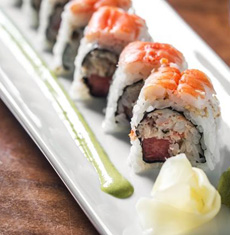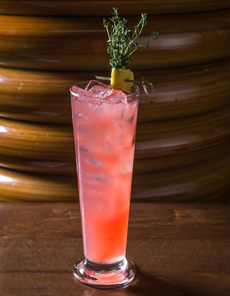FOOD FUN: Watermelon Sushi
|
We just finished National Watermelon Month (July), but National Watermelon Day is coming up on August 3rd. Here are two ways to enjoy it that may not yet be in your repertoire. Mango has been a familiar ingredient in sushi rolls for years. But it’s summertime, the season for for watermelon. In the spirit of eating seasonally, Haru Sushi substitutes fresh watermelon for the mango in a roll made with snow crab, green onion and mint. It’s topped with shrimp and served with a lemon dressing in addition to (or instead of) soy sauce. If you want to make something similar at home, cantaloupe and honeydew work equally well. Haru pairs the Watermelon Roll with Watermelon Lemonade, a sweet-tart blend of lemon-infused vodka, saké, St. Germain Elderflower liqueur (a NIBBLE favorite), fresh watermelon, lemon juice and thyme-infused simple syrup. The recipe is below. |
|
|
|
If you’d rather have someone make them for you, head to one of Haru’s five locations in Manhattan and one in Boston. And if you’d like to know the different types of sushi better, check out our Sushi Glossary. RECIPE: WATERMELON LEMONADE Ingredients Per Drink |
||
|
|
Preparation 1. MAKE the simple syrup: Combine the thyme, sugar and water in a saucepan and bring to a boil, stirring to dissolve the sugar. Remove the pan from the heat and set aside to cool. Strain the thyme from the syrup and refrigerate in an airtight container. 2. MUDDLE the watermelon cubes in a mixing glass. Add the remaining ingredients (except garnish) and ice, and shake vigorously for 8-10 seconds 3. POUR into a tall, ice-filled glass. Garnish with thyme and lemon peel. Watermelon, Citrullus lanatus, is believed to have originated in the Kalahari Desert of southern Africa (it covers much of Botswana and parts of Namibia and South Africa). An ancestor of the modern watermelon still grows wild there. Watermelon is a member of the botanical family Curcurbitaceae. Its cousins include cucumbers, gourds, pumpkins and squash. |
|
|
Watermelons are about 92% water—that’s how they got their English name. In ancient times, travelers carried watermelons as a substitute for potable water, which was not easy to find. Watermelon was cultivated as early as 2000 B.C.E. The first recorded watermelon harvest occurred nearly 5,000 years ago in Egypt. You can tell how much the Egyptians enjoyed watermelon: Seeds were found in the tomb of Egyptian Pharaoh Tutankhamen, so his farmers could grow it in the afterlife. Thirsty traders passing through the Kalahari, refreshed by the fruit, began to sell the seeds along the trade routes. The cultivation of watermelon spread throughout Africa. Most culinary historians believe that watermelon spread from Egypt to other Mediterranean basin countries on merchant trading ships. According to John Mariani’s The Dictionary of American Food and Drink, the word first appeared in English dictionaries in 1615. Watermelon seeds came to the U.S. with African slaves as well as with British colonists. Watermelon was cultivated in China and other parts of Asia by the end of the 9th century C.E. or the early 10th century. Today China is the world’s number one producer of watermelon, Turkey is the second-largest producer and Iran is third. The U.S. is the world’s fourth-largest producer of watermelon, tied with Brazil. Watermelons come in a variety of shapes and sizes: Oval, round, even square, developed in Japan for smaller refrigerators. The flesh can be red or yellow; botanists have also developed varieties with orange and white flesh and even this multicolored blue-green watermelon.
|
||




